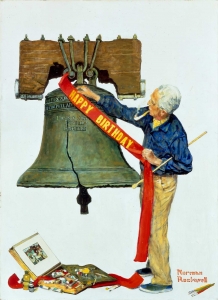
Norman Rockwell (1894-1978)| Liberty Bell (Celebration), 1976 | Cover illustration for American Artist (July 1976) |Oil on canvas | Norman Rockwell Museum Collection, NRM.1988.1
On one of my first days at the Norman Rockwell Museum someone presented me with the following statement, “Above all else, Norman Rockwell was a salesman.” This then begs the question, what exactly was Norman Rockwell selling? Despite all of his advertising work and his ability to make a used car look great, I think the vast breadth of his career suggests a deeper and more expansive sales pitch. He was trying to sell us the American way of life, the pleasant, the not-so-pleasant, the quaint, the familial–everything. In many ways, I think he succeeded. However, there is one painting in particular that I think may fully capture Rockwell’s feelings about the nation.
Norman Rockwell was already in his early eighties by the time the bicentennial celebration began in 1976. He was beginning to lose eye-hand coordination and his vision was hindered by cataracts. None of his ailments however could prevent him from doing what he did best, celebrating America. So in 1976, to commemorate the birthday of the nation he had spent his whole life depicting, Norman Rockwell painted his last magazine cover entitled, Liberty Bell (Celebration), commissioned by the periodical American Artist. It is as much a celebration of America’s survival as it was a celebration of its world and domestic triumphs in the twentieth century. There were certainly times in his life when the country’s resilience was put to the test. Norman Rockwell had lived through two world wars, two military conflicts in South East Asia, the Great Depression, the Cuban Missile Crisis, and decades of racial inequality and unrest. But despite all of that,America survived.
It must have been with pride and optimism that Rockwell painted himself hanging a “Happy Birthday” sash on the Liberty Bell for the bicentennial festivities. There is great symbolism in the Bell itself and in Rockwell’s choosing of it rather than the Statue of Liberty or any other piece of patriotic iconography. I think it is symbolic because of how that particular icon strays from the traditional canon. The major visual difference between the Liberty Bell and any other American icon is that the bell is flawed. It’s physically cracked and yet, damaged liberty still prevails. Norman Rockwell knew better than most people the flaws that the American system can sometimes poses. Throughout his career themes like poverty and racial inequality appear again and again as omnipresent facets of American life. Works like Rockwell’s 1965 How Goes the War on Poverty? or his infamous 1963 The Problem We All Live With, brings this immediately to mind. Norman Rockwell once said, “Without thinking too much about it in specific terms, I was showing theAmerica I knew and observed to others who might not have noticed. My fundamental purpose is to interpret the typical American. I am a story teller.”
Norman Rockwell (1894-1978); How Goes the War on Poverty?, 1965*; Illustration for article of the same name by Sargent Shriver, Look (July 27, 1965); Oil on paper; Norman Rockwell Museum Collection, NRACT.1973.120
Because of the assured liberties that Rockwell knew so well, Freedom from Want, Freedom of Speech, Freedom from Fear, and Freedom of Worship, Liberty Bell (Celebration) shows his willingness to embrace America for all it is, flaws and all. In the painting, Rockwell and the bell stand before a stark white background. It is as if, despite the intricate and quaint worlds created in the background of so many of his paintings, America’s relationship with liberty is not indigenous to any specific place but rather, resides in the classical American aesthetic that Rockwell loved so much. Perhaps the painting supplies at his feet indicate the unfinished nature of the republic and the ambition he had to improve the country as if it was one of his own works of art.
* The finished illustration was over painted with a quote by Lyndon B. Johnson: “Hope for the Poor, Achievement for Yourself, Greatness for Your Nation.”
July 12, 2012
By Matthew Guariglia, NRM summer intern and will be student in Graduate School for History at New York University, Fall 2012







